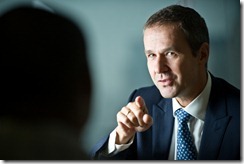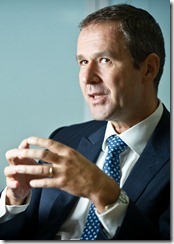In its fourth quarter earnings release Ericsson warned of short-term challenges as operators remained cautious with their spending plans, as a result of factors including macro-economic and political uncertainty. Anders Lindblad, Ericsson president of Region Middle East placed Ericsson’s Q4 and 2011 performance in regional perspective
Lindblad said one of Ericsson’s strengths is being more pro-active with customers than any of its competitors
Ericsson reported that its overall fourth quarter profit fell by 66 per cent as spend shifted to lower margin projects, while revenue growth was flat, up one per cent year-on-year.
The picture for the whole year was more encouraging, with the telecom technology provider reporting that net income increased by 12 per cent, on revenue that was also up 12 per cent for the period.
In the Middle East, sales in Q4 increased by 12 per cent year-on-year, and two per cent for the full year. The region continued to be negatively impacted by political unrest in many countries, with operators continuing to be cautious with infrastructure investments. However, Ericsson also noted that the deployment of LTE as well as WCDMA/HSPA in parts of the region had resulted in positive network sales both year-on-year, sequentially and for the full year.
“The first half of 2011 was when the initial impact of the Arab Spring was first felt,” Anders Lindblad said. “The second quarter was weak, but after that we witnessed more positivity and a stabilising view in the second half of the year.”
As a general trend in the region, Lindblad said the available funds for operators to invest in capex and infrastructure investments became more difficult to come by in the first half of 2011, with many service providers shifting their attention to opex considerations and efficiency drives.
“Operators’ search for greater operational efficiencies increased our business significantly in 2011, and we counted 12 managed services contracts in the region and 70 million subscribers under management at the end of the year,” Lindblad said.
Service providers’ focus on driving efficiencies is expected to continue in 2012 and beyond, with the likes of MTN Group having recently announced the extension of a managed services agreement with Ericsson for its operations in Ghana, for example.
The announcement marked the extension of the first managed services contract between Ericsson and MTN, originally signed in 2009 in connection to the roll out of MTN’s 3G network in Ghana. Under the extension, Ericsson is responsible for network operations, field maintenance and optimisation.
Within the Middle East region, the growth in smartphone penetration is a development Ericsson believes will see service providers needing to invest further in network capacity and quality, as well as in services in order to manage content delivery and access.
“There is potential on the network build-out side of things in the Middle East,” Lindblad said. “While the sales in services were almost equal to the sales in networks in the Middle East in Q4, in China, networks sales accounted for more than twice the amount of services sales, so I believe there is still network growth potential in our region.”
In Saudi Arabia, a market well known for its impressive mobile data usage and high smartphone penetration, Saudi Telecom Company (STC) in February selected Ericsson as one of the main vendors in the telco’s deployment of its LTE network in the kingdom. Utilising Ericsson’s end-to-end LTE solution, STC will be able to enable true high-speed Internet, rich multimedia applications such as high definition (HD) video streaming and chatting, cloud services and conferencing, and high definition applications. 
Ericsson is keen to develop into a “global delivery machine”, which will leverage on partnership and cooperation where necessary, Lindblad says
In addition to managing the existing STC 2G and 3G networks, Ericsson will also manage the new STC LTE network whereby Ericsson will optimise, manage, operate and continuously improve STC’s 2G, 3G and now 4G networks. Ericsson will also introduce a new subscriber data model that will facilitate management and access to data, launch of new services, connecting to the cloud and independent scalability of storage and processing capacity. Ericsson will also introduce an Evolved Packet Core (EPC) with STC that will act as a common core network solution supporting 2G, 3G and 4G/LTE technologies providing additional capacity and throughput.
“We are better at being pro-active with our customers than any of our competitors,” Lindblad said. “We are highly focussed on helping our customers directly,” he added.
The ability to provide a complete end-to-end solution is becoming one of Ericsson’s strongest competitive advantages at a time when many of its competitors are divesting from what they consider as non-core activities in order to focus on growth in high margin activities.
The completion of the acquisition of Telcordia, the operating and business support systems (OSS/BSS) specialist, for example, offers Ericsson added competence in the areas of customer care, billing and service delivery platforms at precisely the time the amount of data being pushed through networks is increasing exponentially and needs further management and optimisation.
“Service providers need transformation otherwise they will be left behind,” Lindblad said. “At the same time the growth in data services is a fantastic opportunity for service providers should they put the right strategies in place around systems integration and processes,” he added.
Ericsson’s acquisition and integration of the activities of billing specialist LHS is another example of the telecom technology company’s ambition to develop into a one-stop provider of telecom and telecom-related hardware and software solutions.
Growth areas for Ericsson remain in mobile broadband, managed services, and operating and business support systems and Lindblad is confident the Middle East shall remain a strong business opportunity for these activities. 3G networks continue to be rolled out in the region, issues surrounding the allocation of spectrum for 4G are being sorted out, and service providers continue to look to ways to make savings in their operational activities, with the view to better managing their networks.
Ericsson thus continues to maintain a long-term perspective for the region and is cautiously optimistic regarding the prospects for telecommunications going forward. The establishment of a “global delivery machine”, as Lindblad describes the end-game of Ericsson’s on-going strategic bets, are sure to resonate in the region and beyond for some time to come.





0 comments ↓
There are no comments yet...Kick things off by filling out the form below.
Leave a Comment